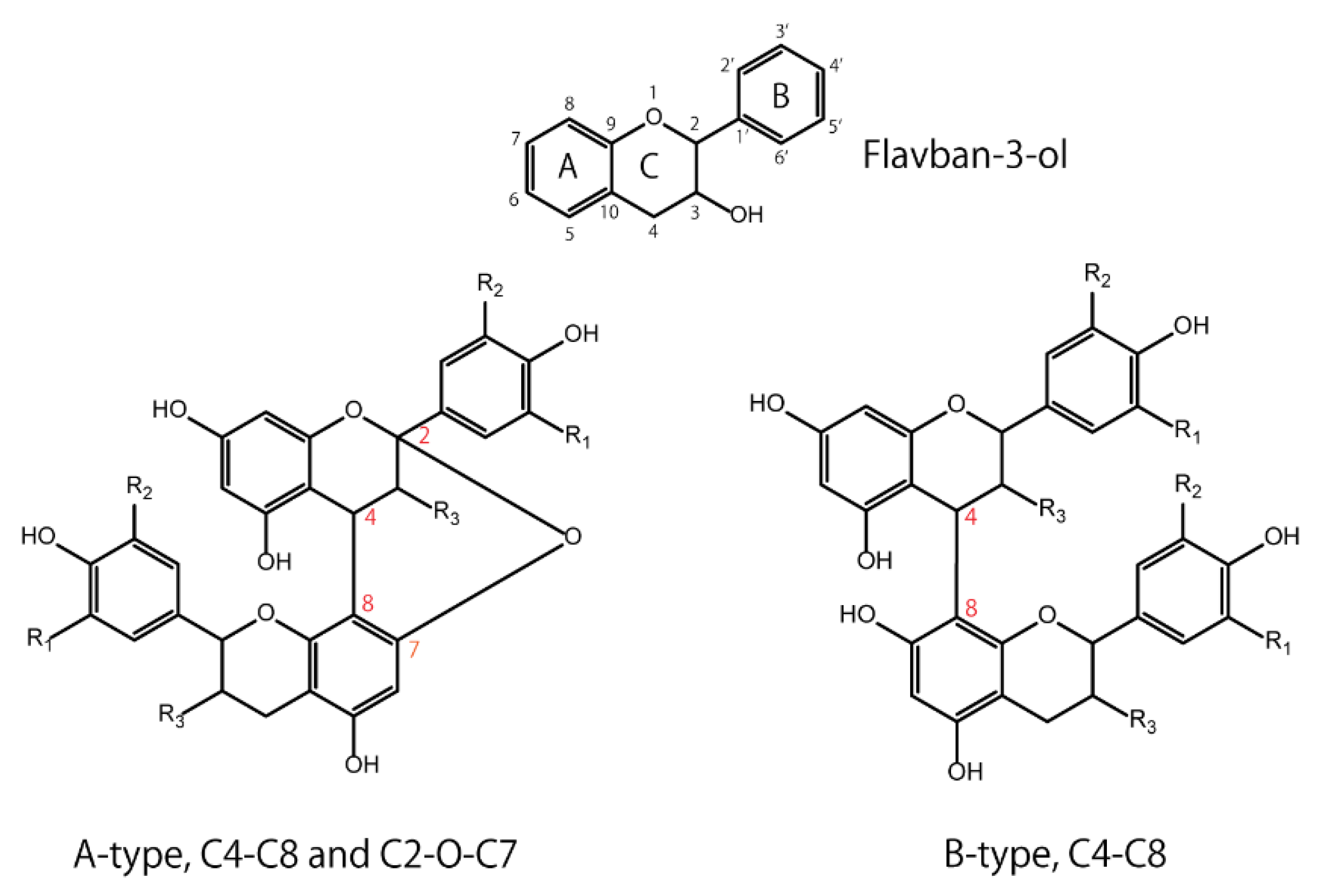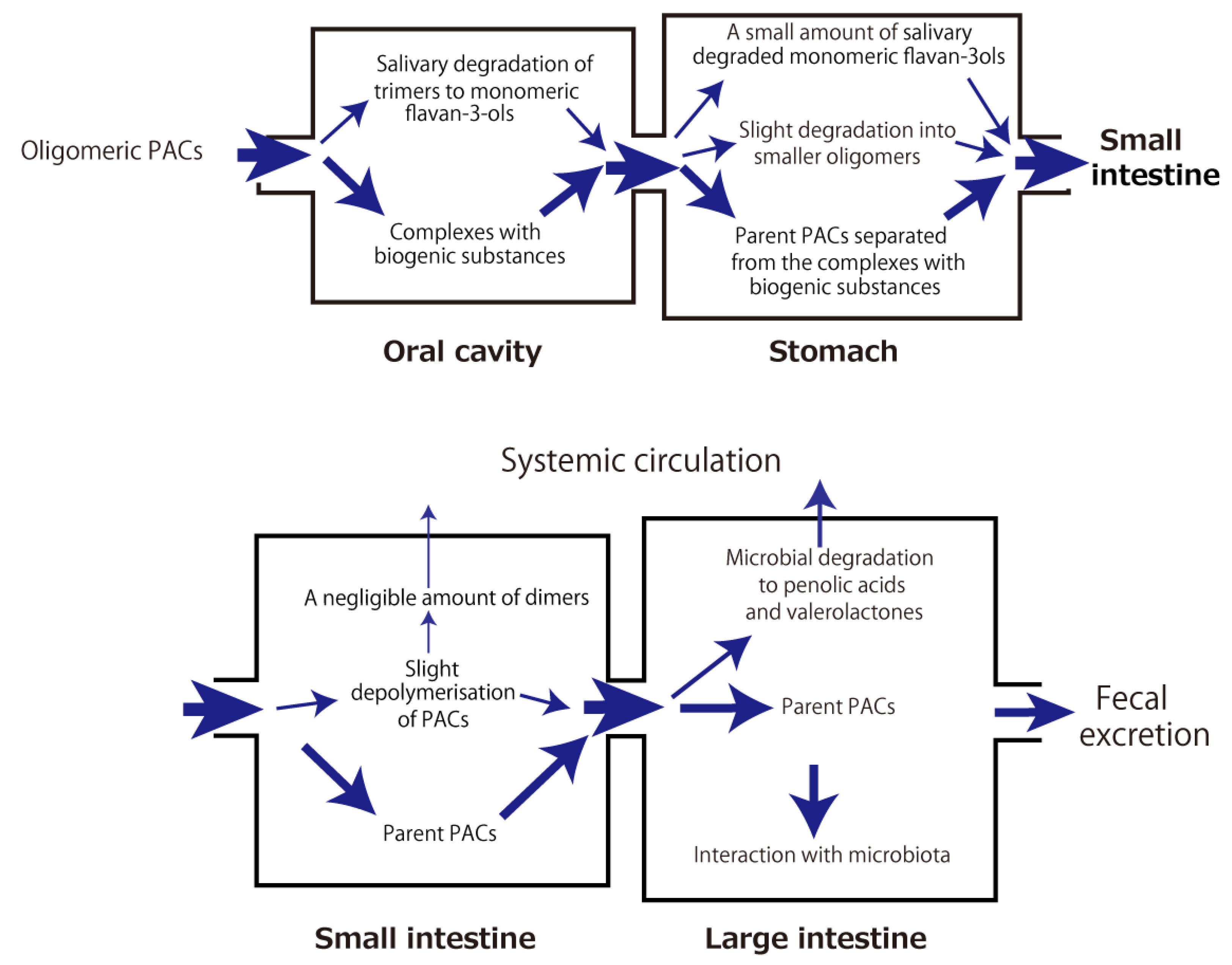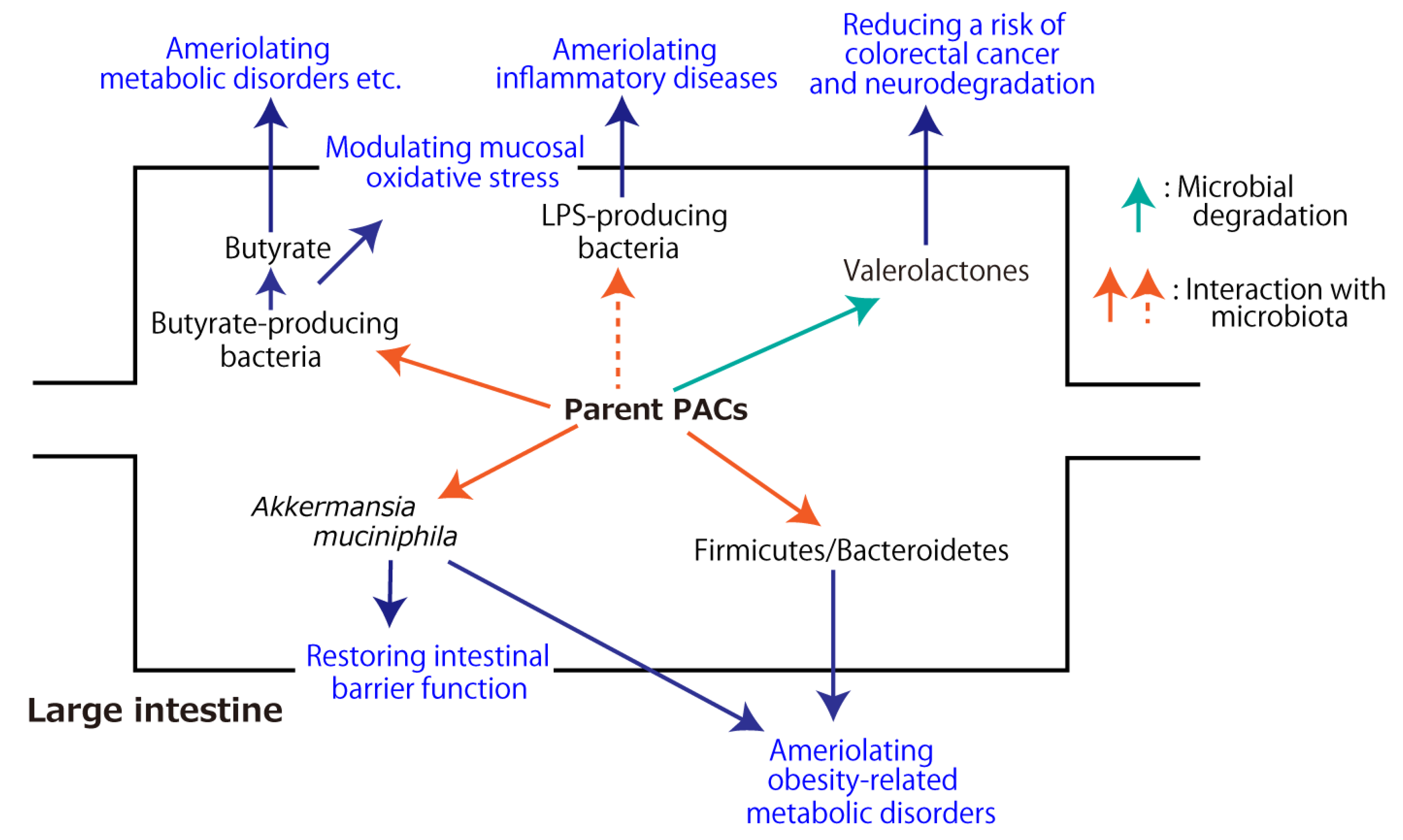1000/1000
Hot
Most Recent

| Version | Summary | Created by | Modification | Content Size | Created at | Operation |
|---|---|---|---|---|---|---|
| 1 | Yoshimi Niwano | -- | 6439 | 2023-01-20 03:17:53 | | | |
| 2 | Yoshimi Niwano | -3082 word(s) | 3357 | 2023-01-25 23:15:29 | | | | |
| 3 | Yoshimi Niwano | -1905 word(s) | 1452 | 2023-01-25 23:18:37 | | | | |
| 4 | Rita Xu | -26 word(s) | 1426 | 2023-01-28 04:23:55 | | |
Proanthocyanidins (PACs), which are oligomers or polymers of flavan-3ols with potent antioxidative activity, are well known to exert a variety of beneficial health effects.
Proanthocyanidins (PACs), also known as condensed tannins, are substances that produce red anthocyanidin pigments when decomposed by acid and are oligomers or polymers of flavan-3-ols, such as epicatechin and catechin. They are widely distributed in fruits, grains, and leaves [1][2][3][4][5], especially in cocoa, black soybeans, cinnamon, apples, and grape seeds [6]. In addition, grape seed PACs have an average degree of polymerization (DP) between 2 and 17 [1]. In in vivo studies, PACs alleviated severe acute pancreatitis in mice via their anti-inflammatory properties [7], exerted anti-obesity and anti-diabetic activity in a type 2 diabetes model of KKAy mice [8] and anti-obesity activity in a mouse model of high-fat-diet-induced obesity [9], and showed neuroprotective activity in zebrafish and rat models of Parkinson’s disease [10][11]. Researchers previously demonstrated that orally administered grape seed PACs prevented bone loss in the lumbar vertebrae and femur in ovariectomized (OVX) mice, and they ameliorated the healing of defects created on the calvaria and osseointegration of a tibial implant in OVX rats, likely by counteracting the accelerated osteoclastogenic activity induced by estrogen deficiency [12]. To attain a better understanding of such health-beneficial activities, pharmacokinetic analysis is imperative. However, there is a paucity of evidence related to the structural complexity of PACs.
Flavan-3-ols have a basic structure consisting of A, B, and C rings, in which 3, 5, 7, 3′, or 4′ is hydroxylated. For example, the 3-hydroxylated group has two conformations: the 2,3-cis isomer is (−)-epicatechin, and the 2,3-trans isomer is (+)-catechin. Oligomers are formed by C4–C8 or C2–O–C7 bonds between monomers with these basic structures. The isomers are roughly divided into two groups according to their binding modes—those with C4-C8 or C4-C6 bonds are called B-type, and those with additional C2-O-C7 bonds are called A-type (Figure 1). Naturally occurring B-type PACs are predominant in plants such as cocoa, bayberry, and grapes [13][14][15].

To investigate the gastric stability of PACs, several in vitro studies using simulated gastric juice were conducted, but the results were controversial. PAC oligomers (trimer to hexamer) purified from cocoa were hydrolyzed to mixtures of epicatechin monomer and dimer [16], apple dimeric PAC B2 was almost completely degraded into (−)-epicatechin [17], and the PAC content in an extract of Hypericum perfoliatum L. significantly decreased by 25% [18]. On the contrary, other studies reported that PACs with a high DP (mean DP ≥ 6) from grape seeds were remarkably stable in the gastric environment and did not degrade into more readily absorbable monomers [19][20], PACs from Acacia mearnsii remained stable during gastric digestion in vitro [21], and the mean DP of PACs isolated from Choerospondias axillaris peel was not affected [22]. A human in vivo study showed that cocoa beverage PACs were stable during gastric transit, with the pH of gastric contents increasing from 1.9 ± 0.2 to 5.4 ± 0.2 after consumption [23]. In summary, PACs are depolymerized to some extent under gastric conditions and then pass into the small intestine.
The first step after gastric digestion is exposure to pancreatic juice in the duodenum. It was reported that slight depolymerization of PACs could be observed in an in vitro small-intestinal model that used pancreatic enzymes and bile salts [20]. A similar in vitro study showed that the mean DP of PACs was slightly decreased, which was possibly due to interactions with digestive enzymes [22]. Collectively, PACs were rather chemically stable with respect to depolymerization during their passage through the simulated duodenal digestion.
When PACs reach the colon, they are likely to be affected by gut microbiota. In in vitro fermentation of grape seed extracts that were rich in B-type PACs, the maximum formation of intermediate metabolites, such as valerolactones, valeric acid, several phenolic acids, and gallic acid, was observed at 5–10 h of incubation with fecal microbiota. Subsequently, the incubations (10–48 h) resulted in the appearance of mono- and non-hydroxylated forms of previous metabolites, which was likely due to dehydroxylation reactions [24][25]. These in vitro results were also consistent with those from a human study. When humans consumed a test drink containing PACs with a DP ranging from 2 to 10, γ-valerolactones were mainly detected in the plasma [26], thus rejecting the notion that PACs are broken down into flavanols prior to their absorption. Since two rat studies showed that ingested polymeric PACs were present in the colon as the intact parent compounds [27][28], the parent compounds and γ-valerolactones, as microbiota-generated catabolites of PACs, likely contribute to some health-beneficial effects following oral ingestion of PACs.
Apart from bacterial transformation, PACs could affect the gut microbiota. It was reported that Lachnospiraceae and Ruminococcus are the major butyrate and propionate producers in human fecal samples [29], and butyrate can modulate oxidative stress in the colonic mucosa of healthy humans [30]. Butyrate was reported to lead to more specific and efficacious therapeutic strategies for the prevention and treatment of different diseases ranging from genetic/metabolic conditions to neurological degenerative disorders [31]. In particular, in a human study, the transfer of intestinal microbiota from lean donors increased insulin sensitivity in individuals with metabolic syndrome along with levels of butyrate-producing intestinal microbiota, suggesting that intestinal microbiota should be developed as therapeutic agents for increasing insulin sensitivity in humans [32]. If PACs have the ability to increase butyrate producers, they may work not only for colonic health, but also for systemic health. More recently, it was reviewed that PACs have a prebiotic and antimicrobial role that favors homeostasis of the intestinal environment, thus reducing the survival of Gram-negative bacteria that produce lipopolysaccharide (LPS) [33]. As LPS triggers the activation of the Toll-like receptor-4 (TLR-4) inflammatory pathway, PACs can minimize endotoxemia.
As for animal studies under pathological conditions, most studies applied high-fat diet (HFD)- or high-fat/high-sucrose diet (HFHSD)-induced metabolic syndrome model animals. PAC-rich grape seed/pomace extract [34][35][36], PAC-rich cranberry extract [37], and apple PACs [38] showed improved symptoms of metabolic syndrome concomitantly with an altered gut microbial environment. Some studies revealed that PACs increase Akkermansia muciniphila [34][36] or Akkermansia at the genus level [38], the former of which is a well-known beneficial gut bacterium that improves host metabolic functions and immune responses [39][40][41][42][43][44][45]. Accounting for 3–5% of the microbial community in healthy individuals, A. muciniphila is a mucinolytic bacterium found in the mucus layer of the human gut [46], and it has the potential to restore mucus thickness and intestinal barrier integrity [47][48]. This bacterium also has the ability to decrease the progression of many diseases, such as obesity and type 2 diabetes mellitus [49][50]. As such, A. muciniphila is considered a promising probiotic candidate [44]. At the phylum level, PACs could decrease the ratio of Firmicutes/Bacteroidetes [35][38]. The dominant gut microbial phyla are Firmicutes, Bacteroidetes, Actinobacteria, Proteobacteria, Fusobacteria, and Verrucomicrobia, with the first two phyla being the most common in healthy human individuals [51]. Phylum-level analyses of Firmicutes and Bacteroidetes have shown that they are associated with obesity and that an increased population of Bacteroidetes, as well as a reduced population of Firmicutes, could improve obesity [52][53][54][55][56]. In a human study, the relative proportion of Bacteroidetes was decreased in obese people in comparison with that in lean people, and this proportion increased with weight loss with two types of low-calorie diets [57]. Aside from HFD- or HFHSD-fed animals, PACs normalized the imbalanced Firmicutes/Bacteroidetes ratio observed in OVX mice in a menopause model and prevented OVX animals from having an increased weight [58].
The aforementioned metabolic fate of PACs through the digestive tract and their health-beneficial effects in association with gut microbiota are summarized in Figures 2 and 3, respectively.

Figure 2. Metabolic fate of orally ingested proanthocyanidins

Figure 3. Health-beneficial effects of proanthocyanidins (PACs) associated with gut microbiota. The dashed arrow indicates the inhibitory effect.
A large portion of orally ingested oligomeric and polymeric PACs reach the colon, where a small portion of them are subjected to microbial degradation into phenolic acids and valerolactones. The rest interact with gut microbiota, resulting in improved microbial diversity, which includes an increased amount of beneficial gut bacteria (e.g., Akkermansia muciniphila), which could ameliorate host metabolic functions, and a lowered ratio of Firmicutes/Bacteroidetes at the phylum level, which could mitigate obesity-related metabolic disorders. Further, PACs have the potential to increase butyrate-producing microbiota and decrease LPS-producing bacteria, leading to the prevention and treatment of different diseases ranging from metabolic conditions to neurological degenerative disorders. These microbial changes could confer some of PACs’ health-beneficial effects.